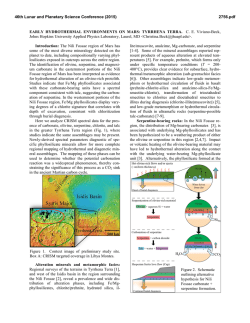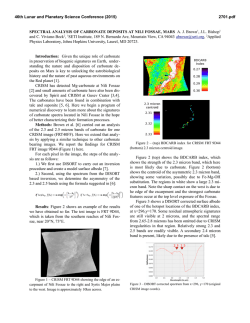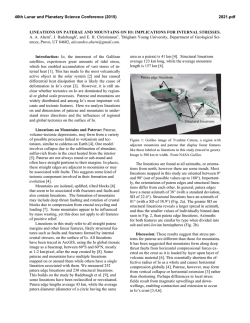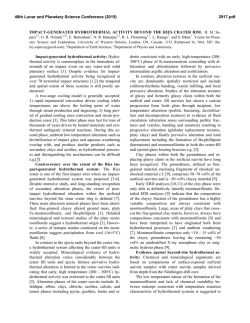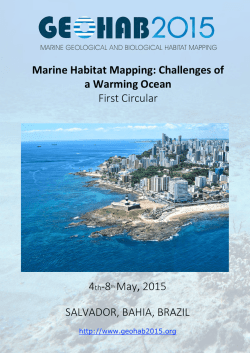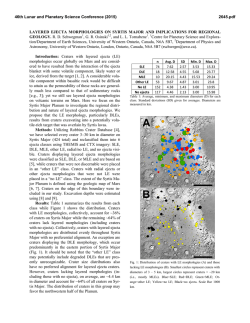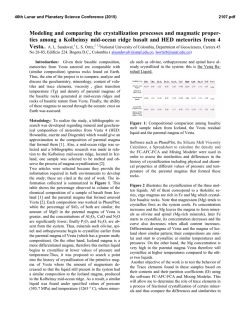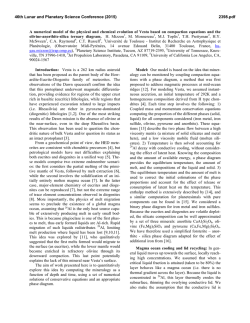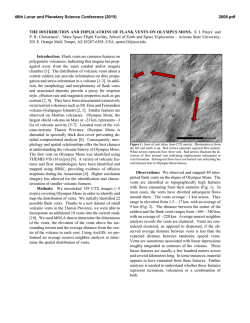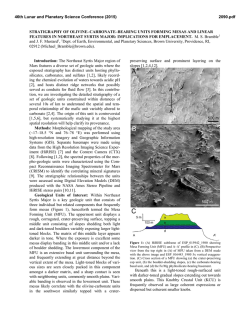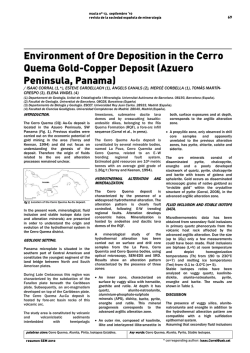
Evolving Magmas, Explosive Eruptions and Hydrothermal Deposits
46th Lunar and Planetary Science Conference (2015) 1783.pdf EVOLVING MAGMAS, EXPLOSIVE ERUPTIONS AND HYDROTHERMAL DEPOSITS AT NILI PATEA CALDERA, SYRTIS MAJOR, MARS. P. Fawdon*1, J. R. Skok2, M.R. Balme1, C. Vye-Brown3, D.A. Rothery1, C.J. Jordan4. 1Department of Physical Sciences, The Open University, Walton Hall, Milton Keynes, UK. MK7 6AA; [email protected], 2Department of Geology & Geophysics, Louisiana State University, Baton Rouge, LA 70803., 3British Geological Survey, Murchison House, West Mains Road, Edinburgh, UK. EH9 3LA, 4 British Geological Survey, Nicker Hill, Keyworth, Nottingham, NG12 5GG. Introduction: Nili Patera is a 45 km diameter caldera at the centre of the Syrtis Major Planum volcanic province [1]. Nili Patera is unique amongst martian volcanic terrains in that it is now below the surrounding planum and hosts a diverse range of volcanic landforms and mineralogies. Our work addresses the stratigraphic and structural context of the caldera, based on these important, and well-known, initial observations: Evidence of effusive and explosive volcanism. A compositional diversity from olivine-rich basalts to dacite [2] and feldspathic units [3]. Outcrops with spectral features indicative of hydrothermal silica [4] in sinter mounds. Asymmetric collapse with a maximum subsidence of 1800 m; dropping the caldera floor below the surrounding volcanic shield. A 300 m high resurgent dome in the western caldera floor. We present a geological map (figure 1) and stratigraphic history of Nili Patera (figure 2) in which these geological findings are put into a nine-part geological history (figure 3). Additionaly, we consider the implications of the caldera’s evolution for the evolution of Syrtis Major Planum and Highland Patera style volcanoes in general. Data and methods: We used six 6 m/pixel Context Camera (CTX) images to generate three Digital Elevation Models (DEMs) using SocetSet software. The DEMs, at 18 m/pixel, were used to orthorectify CTX images as a base layer for the geologic map. Mineralogy was derived from all available Compact Reconnaissance Imaging Spectrometer for Mars (CRISM) visible-infrared spectrometer data. Observations and discussion: Figure 1 shows stratigraphy for our units in Nili Patera and a simplified map summarising the geology and geomorphology. Units are characterised at the highest resolution possible on a mineralogical and geomorphological basis, depending on the availability of derived mineralogy. The extent of units are mapped to the CTX basemap. Figure 1: a. Stratigraphic history of Nili Patera b. Simplified geological map of Nili Patera. 46th Lunar and Planetary Science Conference (2015) 1783.pdf Figure 2: Block diagrams a - i illustrating the volcanic history of the Nili Patera. The diagram is 50 km wide and has 5 times vertical exaggeration. Arrows show the direction of travel for: (Orange) erupted products, (red) magma, (Blue) hydrothermal fluids, and (black) tectonic or structural movement. Conclusions (letters refer to figure 2): • Nili Patera formed between 3.28 (+0.80 -0.13 Ga) and 3.1 (+0.13 -0.22) G. by trapdoor collapse (b-c) into a volcano-tectonic depression thermomechanically weakened by intrusion and magma advection (a). • The bright fractured unit (Bfu), is either part of a felsic pluton exposed during caldera formation or remnants of a welded ignimbrite. Bfu is derived from melting in the Noachian highland basement, either way. • There were five episodes of magmatic action: (i) a basaltic unit erupted from tuya-like vents in the north of the caldera (d); (ii) Nili Tholus and the evolved flow unit (Efu) erupted from an isolated magma chamber (e); (iii) intrusion formed a ~300 m high elliptical dome (f); (iv) a basaltic unit (Mvu) was emplaced from small cones in the east (g); and (v) an olivine-bearing unit (Oru) formed on the western caldera ring fault (i). • The ductile layer beneath Syrtis Major, evolved magma compositions and hydrothermal deposits, imply interaction with subsurface volatiles. Evidence for water and hydrated materials at an elevated geothermal gradient presents a possibile habitable environment (sampled by the hydrothermal deposits in Nili Patera). • The similarities to other highland paterae imply a similar causal mechanism and thus astrobiological potential for those edifices too. References: [1] Hiesinger, H. and J.W. Head, J. (2004) JGR 109(E1) E01004. [2] Christensen, P.R., et al., (2005) Nature, 436(7050) 504-509. [3] Wray, J.J., et al., (2013) Nature Geosci, 6(12): p. 1013-1017. [4] Skok, J.R., et al., (2010) Nature Geosci, 2010. 3(12): p. 838-841. [5] Silvestro, S., et al., (2010) GRL 37(20): p. L20203. [6] Robbins, S.J.,et al., (2011) Icarus,. 211(2): p. 1179-1203.
© Copyright 2026
